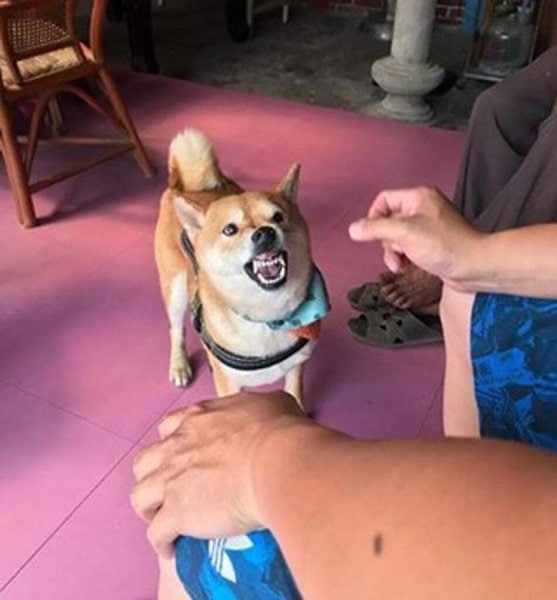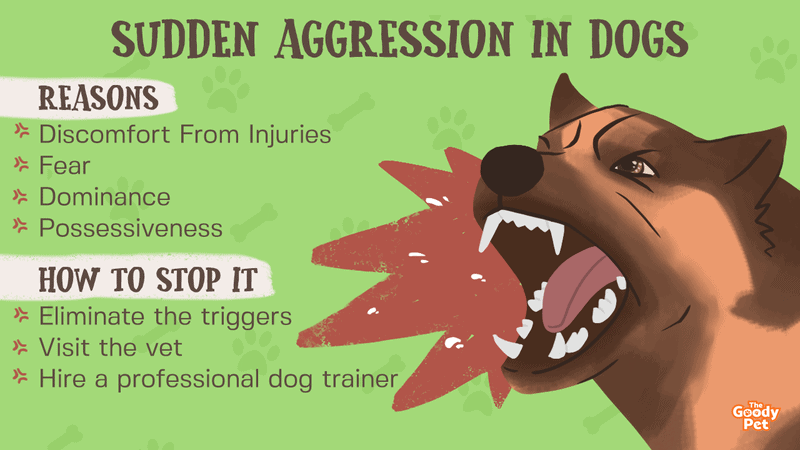Dogs are meant to be man’s best friend. So, when a dog suddenly becomes aggressive and turns against its owner or other people and dogs, the first question that comes to your mind is why your friendly and docile dog has gone wild all of a sudden.
Sudden aggression in dogs can be caused by pain from injuries and illnesses, fear, dominance, and possessiveness. Redirected anger, age, and the dog’s gender can also determine aggression in dogs. Of all these, fear is the most common cause of dog aggression.
Because sudden aggression in dogs can get out of hand and cause injury to people and other animals, finding the cause is an important first step in curbing your dog’s aggression. This article is a comprehensive write-up on the causes of sudden aggression in dogs. We’ll, however, start you off with what seems the most urgent question in these situations: “How do I stop my dog from sudden aggression?”
How Do I Stop My Dog’s Aggression All Of A Sudden?
As we’ll tell you later in the article, the first thing you need to do to stop dog aggression is to understand the underlying causes.
Depending on the cause, there are 3 sequential measures you can consider to stop sudden aggressive behavior in dogs:
Eliminate Dog Aggression Triggers
If you notice that certain situations, objects, people, or animals are triggering your dog’s sudden aggressive behavior, keep your pet away from such triggers until the vet can assess your pet and rule out underlying medical issues.
Use a crate to temporarily confine your dog if you need to when aggression triggers can’t be kept at bay. For example, if your dog is aggressive towards a newborn baby in the family, keep the dog caged when the baby is in the spaces where your dog is also allowed.

Visit Your Dog’s Veterinarian
A visit to the veterinarian when your furry friend becomes aggressive all of a sudden is paramount.
Your dog’s doctor will do a complete veterinary examination to confirm or rule out any underlying medical issues.
Medical conditions like hypothyroidism and pain-causing injuries can be treated to restore your dog’s non-aggressive personality while others like epilepsy and advanced cancers can be managed.
Hire A Professional Dog Trainer And Work With A Canine Behaviorist
If the vet rules out medical issues at the root of your dog’s aggression, proceed with behavioral interventions by hiring a dog behaviorist to help understand your dog’s sudden change of behavior.
The behaviorist may ask you to change certain things about relating with your dog. You can then make a follow-up by hiring a professional dog trainer to help correct your pet’s behavior.
As we’ll explain in the last section, the best way to stop aggressive behavior in dogs is positive reinforcement training.
What Causes A Dog To Suddenly Become Aggressive?
Every sudden aggression in dogs has a trigger. The most common causes associated with sudden dog aggression include the following:
Pain And Discomfort From Injuries And Medical Conditions
If a dog has an injury or an illness that is causing pain and discomfort, it will be very sensitive to touch or disturbance and can suddenly become more aggressive.
Touching a dog in pain could readily make them turn to you and bite, not just to defend themselves from the touch but to communicate that they don’t want anyone triggering the pain.
Also, brain or cognitive-related medical conditions like brain tumors can compromise a dog’s judgment and trigger aggressive behavior.
Some medical conditions that may cause pain to your dog and make the pet aggressive include:
- Bone fractures
- Skin lacerations
- Arthritis
- Internal injuries
- Encephalitis
- Brain tumors
- Head trauma
- Hydrocephalus
- Epilepsy

Fear
According to the AKC Canine Health Foundation, fear is the most common cause of dog aggression, and not dominance as most people tend to think.
Fear in dogs is mostly created by dominance-based training. The result is rush and uncontrolled responses to social and interactive situations.
Fear aggression is most common in younger dogs below 3 years of age and is portrayed as a form of defense.
Dogs with fear aggression may be afraid of certain categories of people or animals and can easily generalize the fear towards similar people/animals or situations where the threat has been perceived.
Dominance
Dominance aggression is a dog’s way of saying it is the alpha in charge of the situation. If a dog feels that its position of dominance is threatened, it will put forth aggressive behavior such as staring, standing over, growling, and biting.
Possessiveness
Possessive aggression is manifested when people or other animals touch or go near objects, people, or places that the dog perceives as its territory. A dog may bite a neighbor who passes by the home because that is its territory.
Other Causes
Other causes associated with sudden dog aggression include frustrations, redirected anger, and age or sex-related changes among others.
What Are Signs Of Aggression In Dogs?
Dog experts will tell you that most aggressive behavior in dogs is never really sudden, you will see some pre-signs following certain triggers.
That is why there is really no such thing as “My dog attacking my other dog for no reason.” The attacked dog may not have seen its canine colleague barring from entering certain spaces or ignoring the dog when it wants to play.
The most common pre-aggression signs in dogs can be categorized into 4 groups:
Avoidance Aggression Signs
Avoidance signs can be read as the dog’s way of saying: “Cut it out. I’m not in the mood.” They include the following:
- Dodging your gaze and avoiding eye contact
- Using a side glance
- Approaching from the back
- Moving away from you

Escape Aggression Signs
This is your dog’s attempt to avoid the occasion for aggression before it happens. We could consider it the ‘flight’ approach in a conflict situation. Escape aggression signs include:
- Walking away
- Going to its cage
- Lying far away from you
Freeze Aggression Signs
These are pre-aggression signs that leave your dog motionless prior to manifesting the aggressive behavior. They include:
- A stiff body
- Raised hairs
- Hard consistent staring
- Shifting its weight forward as though ready to charge
Anxiety And Defensive Aggression Signs
These are behaviors that express uneasiness in a dog before the real sudden aggression is manifested. They are the most obvious to read and most of them can actually be considered real aggression behaviors. They include:
- Growling
- Yawning
- Snarling
- Drooling
- Whining
- Stretching
- Biting and nipping
- Looking in every direction
- Lunging
- Punching with the muzzle
The common characteristic with these sudden aggression signs is that they are not your dog’s usual behavior. Instead, they precede sudden aggression incidents (they are pre-aggression signs).
What Illness Causes Dogs To Become Aggressive?
You’ve probably heard someone whose dog has suddenly become aggressive say that their dog “is possessed.” But can a dog be psychotic or have mental issues?
Veterinarians agree that dogs can suffer from mental disorders but will exhibit them in a way different from humans. Also, most mental issues in dogs are caused by human behavior.
Dog mistreatment, the use of dominance methods in training, and medical conditions that adversely affect your dog’s body and cause consistent pain can cause mental issues and the consequent aggression in canines.
Mental Issues And Disorders That Lead To Dog Aggression
These are issues related to the dog’s cognitive processes and include:
- Anxiety – Dogs can become anxious and aggressive when their routine is altered, go through traumatic experiences, or suffer separation from family.
- Depression – Described as extreme sadness in your dog that causes them to be uncertain and turn to sudden aggression.
- Compulsive behaviors – Exaggeration of usual behaviors so that your dog results in uncontrolled acting like sudden aggression.
- Behavioral seizures – These occur in the hypothalamus, the brain region that controls aggression. They can manifest in sudden unexplained aggression and sudden mood change.
Note that dogs do not suffer from bipolar disorder, even though they may manifest sudden mood change.

Medical Conditions That Lead To Dog Aggression
Illnesses and diseases that affect the brain, deplete your dog of body minerals or induce consistent pain can predispose your dog to aggression.
- Hypothyroidism – An autoimmune condition that causes low production of the thyroid gland, causing hormonal disorders.
- Neurological problems – These are medical conditions affecting the brain and the nervous system including the earlier mentioned hydrocephalus and encephalitis, head trauma, brain tumors, and epilepsy. These can alter your dog’s perception and judgment, leading to episodes of sudden unexplained aggression.
- Hypoglycemia – Low blood sugar that can cause a range of symptoms including sudden aggression.
- Low calcium levels – Especially common in nursing dogs and can cause sudden incidents of aggression.
- Painful or deafening ear infections – These can cause your dog to be startled and become aggressive.
Can You Train Aggression Out Of A Dog?
According to the American Society for the Prevention of Cruelty to Animals (ASPCA), the question of whether an aggressive dog can be cured has varied responses:
Aggression Can Be Reduced Or Eliminated
Depending on the triggers of your dog’s aggression, the frequency of aggression incidents can be reduced and in some cases eliminated through training or medical treatment.
Dog Aggression Can Be Recurrent
A dog that has been aggressive before can be aggressive again, and there is no guarantee your dog is going to be completely cured.
So, if your dog has been trained out of aggression, you should always have the approach of recovering addicts; there’s always a risk your dog can slip back to aggression and you should never let down your guard.
The Only Solution To Dog Aggression Is Managing It
Whether your dog is aggressive due to environmental or medical triggers, you’ll need to learn to consistently manage the behavior.
- If the triggers are medical, work with your dog’s vet to treat a curable condition or manage a chronic/terminal.
- If the triggers are environmental, limit your dog’s exposure to the triggers and have the dog trained to stay calm in the presence of such triggers.
The Best Way To Break Dog Aggression Is Positive Reinforcement
There are different approaches to training a dog out of aggression:
- Desensitization – Exposing the dog to a stimulus gradually until it gets used and reacts positively.
- Counter-conditioning – Training the dog to react to a stimulus with different behavior.
- Positive reinforcement – Operant conditioning/reward training.
Among these, the best way to break a dominant dog is through positive reinforcement training. It entails rewarding non-aggressive behavior to encourage its repetition.
The reward can be a treat or a verbal compliment and should be given as soon as the dog refrains from aggression so that it can associate the reward with refraining from aggression.
Related Questions
Do Dogs Get More Aggressive With Age? Studies suggest that dogs can get more aggressive with age. This is especially attributed to change in the environment as when a new puppy is brought to the family, biological changes in the geriatric phases, and the onset of age-related diseases and illnesses. A study in 2019 found that dog aggression peaks around 6 to 10 years of age.
Which Dogs Attack Their Owners The Most? Surveys on dog aggression indicate that Bull-type dogs and Rottweilers are the breeds that attack and show aggression most. For example, a survey between 2005 and 2017 showed that the top 7 breeds involved in fatal attacks on humans in the US were the Pit Bulls, Rottweilers, German shepherds, Mixed-breed dogs, American Bulldogs, Bullmastiffs, and Huskies in that order.
Can Dogs Live Together After Fighting? Yes, dogs can live together after fighting if you train them to do so. Since dogs usually fight over resources or to assert dominance, training your dogs in dog-to-dog socialization, introducing new dogs gradually, and separating resources like feeding each dog separately are all successful ways of helping your dogs coexist in the home.





